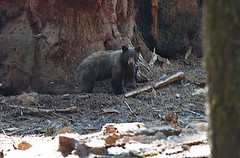![]() Andrew Mora offers a review of the Biology department seminar by Rachel Mazur.
Andrew Mora offers a review of the Biology department seminar by Rachel Mazur.
The American Black Bear, Ursus americanus, is currently the only species of bear in the state of California. In a fascinating presentation by Rachel Mazur, pictures and videos were used to depict the beauty of these bears in their natural and not so natural environments; the latter being bears foraging for food in developed areas of the national parks including getting food out of trash cans, cars, etc.
 According to Mazur, these bears are especially hungry during the months of March and April. During this time, a bear is either termed by Mazur to be a wild foraging bear, which consists of eating grasses, roots, insects from shredding logs etc., or they can be food conditioned bears, which consist of getting their nutrition from developed areas, or humans.
According to Mazur, these bears are especially hungry during the months of March and April. During this time, a bear is either termed by Mazur to be a wild foraging bear, which consists of eating grasses, roots, insects from shredding logs etc., or they can be food conditioned bears, which consist of getting their nutrition from developed areas, or humans.
Research by Mazur finds that bears have traits for social learning and the most critical times of a bears learning process is during the first year when they are in constant contact with their mother (Mazur, 2008). Three separate hypotheses were compared to describe how these bears are learning to become food-conditioned to developed areas. The first is that bears inherit these behaviors from their mothers and can be predicted (Mazur, 2008). The others include bears learning individually (that is, without the help of the mother) and transmitted learning from sow to cub (Mazur, 2008).
The methods used for this experiment were efficient in that homogeneity was taken into consideration. Therefore five variables were taken into consideration including park, sow identity, sow behavior, rearing method and cub outcome (Mazur, 2008). The two national parks which Mazur encouraged everyone to visit include Sequoia National Park and Yosemite National Park. From showing clips of a movie on this research, it was evident that many years of hard work by numerous staff was done to work with these bears and monitor their statuses.
Mazur stated that she was very pleased with the results that they came across. An easy to read table of her results shows the number of sows that they started with (23 food conditioned and 9 wild), the rearing methods of these sows (rearing in wild or food-conditioned rearing), and the outcome of the cubs once separated from their mothers (Mazur, 2008).
Conclusions made by Mazur asserted that rearing method had a highly significant effect on the cub outcome (Mazur, 2008). If a cub was reared food-conditioned, it was much more likely to be food-conditioned once separate from its mother. That being said, the last hypothesis stated by Mazur was seen to be the most accurate: that bears become food-conditioned through social learning.
In both seminar and paper, Mazur stated that there are numerous implications for the work that has been done. She posed a question to the room regarding the bear’s possibility of creating culture and even tradition in our national forests with these new food-conditioned characteristics (Mazur, 2008). What I found beneficial in this work is the implication that food-conditioning in developed areas in our national forests do not necessarily imply adaptive strategies of these Ursus americanus, but may very well be falling into an ecological trap (Mazur, 2008). I also found it interesting for her to note that science and management have recently become less taboo as a pair in the scientific world.
Reference:
R MAZUR, V SEHER (2008). Socially learned foraging behaviour in wild black bears, Ursus americanus Animal Behaviour, 75 (4), 1503-1508 DOI: 10.1016/j.anbehav.2007.10.027













0 comments:
Post a Comment